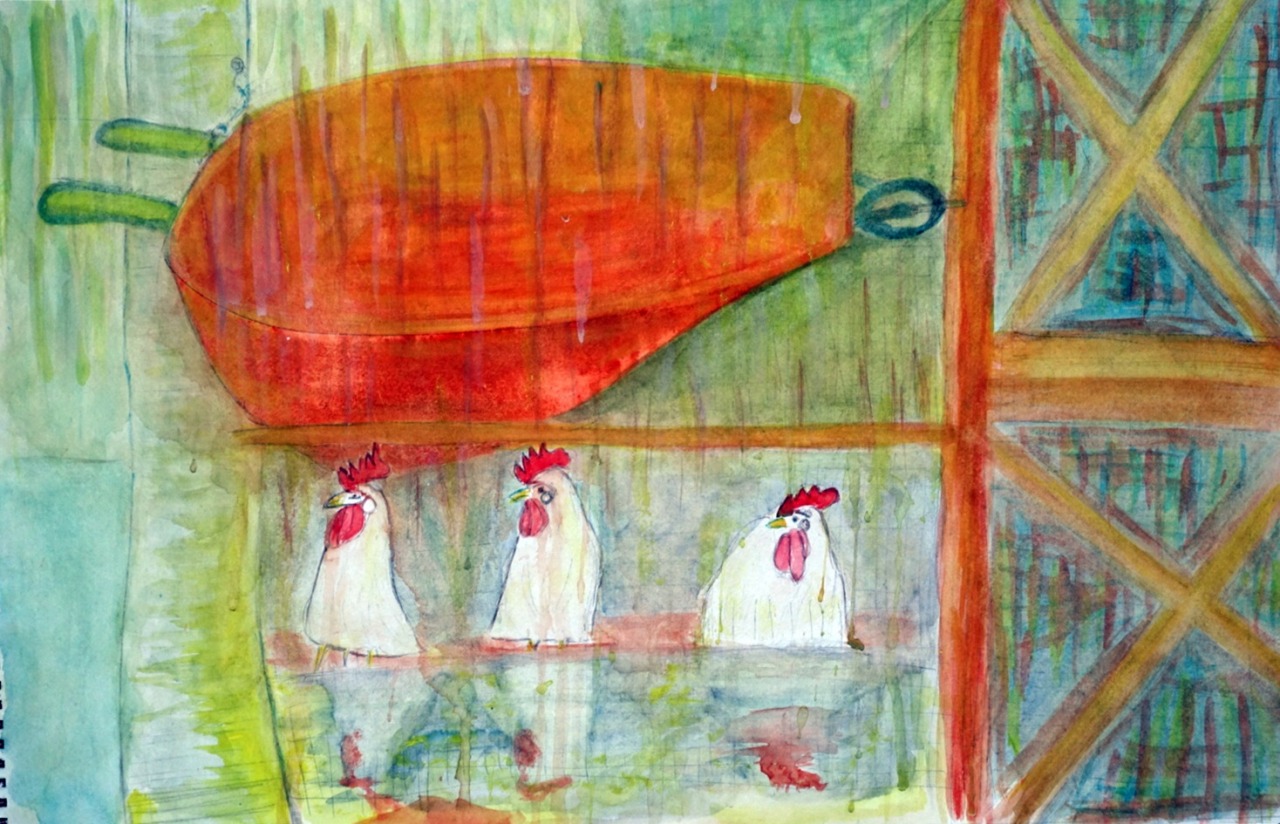Comments
-
Get Creative!The Red Wheelbarrow
William Carlos Williams, 1883 - 1963
so much depends
upon
a red wheel
barrow
glazed with rain
water
beside the white
chickens.

-
Bad ArtDuchamp's Fountain is anti-aesthetic. Duchamp's contextualizes a found object as art, many do not find it aesthetically pleasing, but as a conceptualization it is pleasing, as conceptual art.
Opposite this Any Warhol's Brillo Boxes, Campbell Soup Cans, Cokes, Mariyln. Warhol's works are aesthetically brilliant. He was only interested in the surface of objects, he created an aesthetic of consumerism. His works are representative of the function/mechanization of consumerism.
Warhol's 1975 book, The Philosophy of Andy Warhol.
What's great about this country is that America started the tradition where the richest consumers buy essentially the same things as the poorest. You can be watching TV and see Coca-Cola, and you know that the President drinks Coke, Liz Taylor drinks Coke, and just think, you can drink Coke, too. A Coke is a Coke and no amount of money can get you a better Coke than the one the bum on the corner is drinking. All the Cokes are the same and all the Cokes are good. Liz Taylor knows it, the President knows it, the bum knows it, and you know it.
A sort of synthesis of these might be in the work of Sherrie Levine, who like Duchamp appropriates objects in her art. Unlike Duchamp, or Warhol, she does not appropriate ordinary objects, the objects of her appropriation are existing works of art.

Left: Sherrie Levine, After Walker Evans, 1981; Right: Walker Evans, Alabama Tenant Farmer's Wife, 193613
She took existing art photograph and re-photographed it. The work, which already has aesthetic merit is re-contextualized, bringing it back into the the gallery and our conversations about art. -
Get Creative!In a Station of the Metro
Ezra Pound, 1885 - 1972
The apparition of these faces in the crowd;
Petals on a wet, black bough.

-
Dreaming.From Psychology Today 10/28/10
Matthew Wilson and Kenway Louie of the Massachusetts Institute of Technology have evidence that the brains of sleeping rats are functioning in a way that irresistibly suggests dreaming. Much of the dreaming that you do at night is associated with the activities that you engaged in that day. The same seems to be the case in rats. Thus if a rat ran a complex maze during the day he might be expected to dream about it at night. While a rat was awake and learning the maze, electrical recordings were taken from its hippocampus (an area of the brain associated with memory formation and storage). Researchers found that some of these electrical patterns were quite specific and identifiable depending upon what the rat was doing. Later, when the rats were asleep and their brain waves indicated that they had entered the stage where humans normally dream, these same patterns of brain waves appeared. In fact the patterns were so clear and specific that the researchers were able to tell where in the maze the rat would be if it were awake, and whether it would be moving or standing still. Wilson cautiously described the results, saying, "The animal is certainly recalling memories of those events as they occurred during the awake state, and it is doing so during dream sleep and that's just what people do when they dream."
Dream time seems to enable our memory to consolidate what it has experienced during the day.
If our experience of fiction, film or TV take an active role in our life, then a rehearsal of these experiences would not be surprising.
Happy B-Day BC! -
Bad Art

From Gawker
John Cook
Filed to: MEMORIALS8/22/11 4:31pm
But now that it's finally here, we can set the nitpicking aside and concentrate on the fact that it's unpleasant to look at and conceptually incoherent. Basically, the thing is a big rock with the middle sliced out and slid forward. Into that middle slice, a lazily unfinished visage of King has been sculpted, with his legs and back blending into undifferentiated rock like he's the victim of a transporter mishap on Star Trek. The tableau is inspired by a quote from the "I Have a Dream" speech: "With this faith we will be able to hew out of the mountain of despair a stone of hope." So King is trapped in the stone of hope, apparently, even though he talked about hewing said stone, which would mean he is hewing himself? And then the big white rocks behind him are mountains of despair, which are strange things to memorialize in stone.
Good or bad? I don't really know, but Memorial Art can be very good:

I have been to the Wall, touched the Wall, and I saw how others were affected by it.
It befits its subject matter. -
Bad Art

"In the Cat's Mouth" part of the collection of the Museum of Bad Art (MOBA)
http://www.museumofbadart.org/
As the only museum dedicated to bringing the worst of art to the widest of audiences we felt morally compelled to explore new, more creative ways of bringing this priceless collection of quality bad art to a global audience. Another Boston-area cultural institution, Dedham Community Theatre, generously allowed MOBA the use of their basement. Our first permanent gallery is now conveniently located just outside the men’s room in a 1927 movie theatre. The ambience created such a convivial atmosphere, that when we went looking for a second location, the only place that was up to our quality standards was another theatre basement. The Somerville Theater in Davis Square, Somerville MA is now our second gallery.
I think art can be described, but not defined. -
Whose History?"1. The "common trait" between all histories involves the sense of consubstantiality of being ("everything is interlocked")."
I wonder what is entailed by the word "interlocked". Do you mean that the events that unfolded in time can be related to each other causally, or are they related as similar words are related to one another, or is history just "...one damn thing after another" with no causal connection beyond the interpretation the historian places on these events. -
bye!Hey Mongrel, I just got here and you are leaving? Best of wishes and good luck always! Maybe you will come back someday...soon.
-
The compatibility between science and spiritualityAll life is impressionable, and all life is part of the universe/nature, therefore Nature is in part impressionable. Nature changes and with the coming of man, an infinitesimal part of Nature becomes self-aware.
What does it mean to be a man, to be self-aware? I think it means that something has arisen from matter, which depends intrinsically on matter, is enchained to matter, yet rises beyond matter. How can anything anything rise from matter? How do we connect with matter, where is that connection. Science chases after this connection, we live it, but we don't live it alone, it is always with other men, who we rely on, love, hate, play...
We are always with others, the majority of what we know is based on what others have learn't and taught us. I think spirit is in connection with others, from our emphatic relationship with others, without which there is no 'we'. -
The Ultimate Game of Hide and SeekChild developmental psychologist Alison Gopnik: "The Philosophical Baby: What Children’s Minds Tell Us About Truth, Love, and the Meaning of Life"
"It’s possible that babies literally don’t see a difference between their own pain and the pain of others. Maybe babies want to end all suffering, no matter where it happens to be located. For them, pain is pain and joy is joy. Moral thinkers from Buddha to David Hume to Martin Buber have suggested that erasing the boundaries between yourself and others in this way can underpin morality. We know that children’s conception of a continuous separate self develops slowly in the first five years."
Babies demonstrate instinctual empathy, among other things. If there is a god, I think he is found in our relationship with others, in a congregation of believers who emphatically respond to the call of the spirit of god that arises in the spirit of a congregation. -
Why be moral?"To make it simple. Explain to me the difference between these possible worlds:
1. No morality.
2. It is immoral to kill babies.
3. It is moral to kill babies.
It seems to me that the only difference is that in the second one we would be correct in believing that it is immoral to kill babies. But what difference would being correct make to being incorrect? Presumably, regardless of what is or isn't the case, you wouldn't kill babies. Or would you convert to baby killing if you'd found it to be moral? In the unlikely case you'd say yes: then it's your belief that matters, not the fact-of-the-matter -- what difference does the fact-of-the-matter make?"
I wonder if it is that simple. There appear to be other motivations that have and continue to subvert a moral view of this world.
During the Holocaust 1.5 million Jewish were killed in order to purify the Aryan race from their 'taint'. The primordial or elemental kinship between people became racially motivated and it led to the slaughter of multitudes of innocent people. Racism became a nationalist goal. Isn't the ethnic cleansing we have seen, and continue to see, a continuation of that trend? Morality force is replaced by the force of nationalism, and blood.
Also, we live in a dangerous world where letting one's guard down can lead to tragedies such as 9/11. Societies response to this, here and many other countries has led to a defacto Big Brother society, where freedom is sacrificed for the Ideal of Safety.
The massive intrusion of the state, from the demanding of media data, to the nearly ubiquitous presence of cameras surveying the actions of the populations, coupled with an ever improving technology almost read like science fiction or perhaps a the prologue to a totalitarian state. Think about facial recognition software, which is being employed by many countries.
An essential aspect of what is or is not moral is the freedom of the agent. Benjamin Franklin once said: "Those who would give up essential Liberty, to purchase a little temporary Safety, deserve neither Liberty nor Safety." Our desire to be safe overturns our moral concerns.
Cavacava
Start FollowingSend a Message
- Other sites we like
- Social media
- Terms of Service
- Sign In
- Created with PlushForums
- © 2025 The Philosophy Forum

